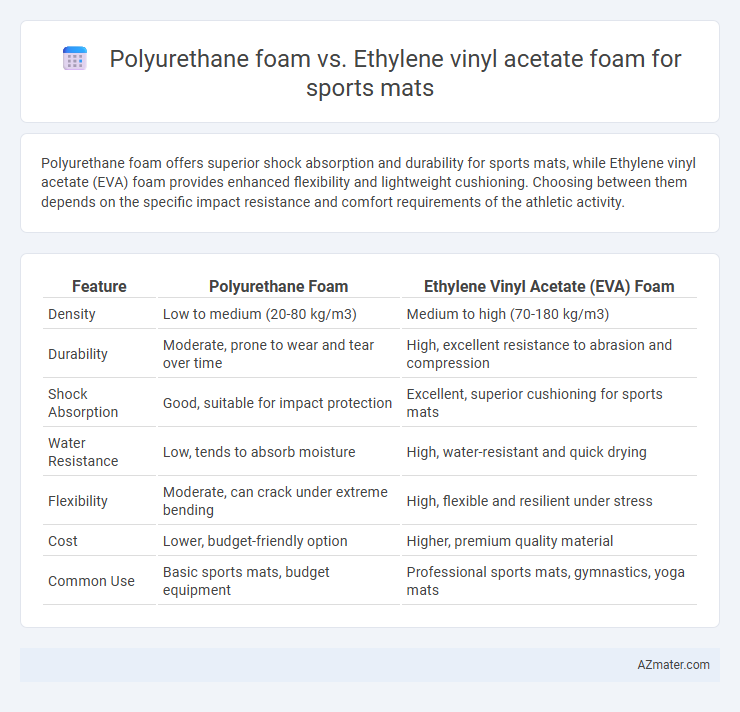Polyurethane foam offers superior shock absorption and durability for sports mats, while Ethylene vinyl acetate (EVA) foam provides enhanced flexibility and lightweight cushioning. Choosing between them depends on the specific impact resistance and comfort requirements of the athletic activity.
Table of Comparison
| Feature | Polyurethane Foam | Ethylene Vinyl Acetate (EVA) Foam |
|---|---|---|
| Density | Low to medium (20-80 kg/m3) | Medium to high (70-180 kg/m3) |
| Durability | Moderate, prone to wear and tear over time | High, excellent resistance to abrasion and compression |
| Shock Absorption | Good, suitable for impact protection | Excellent, superior cushioning for sports mats |
| Water Resistance | Low, tends to absorb moisture | High, water-resistant and quick drying |
| Flexibility | Moderate, can crack under extreme bending | High, flexible and resilient under stress |
| Cost | Lower, budget-friendly option | Higher, premium quality material |
| Common Use | Basic sports mats, budget equipment | Professional sports mats, gymnastics, yoga mats |
Introduction to Sports Mat Materials
Polyurethane foam offers excellent durability and cushioning, making it a popular choice for sports mats requiring high impact absorption and long-term resilience. Ethylene vinyl acetate (EVA) foam provides superior flexibility, lightweight properties, and moisture resistance, ideal for activities demanding enhanced comfort and quick drying. Both materials balance shock absorption and stability, with polyurethane favored for intense impact sports and EVA preferred for versatile, portable mat applications.
What is Polyurethane Foam?
Polyurethane foam is a versatile, high-density polymer widely used in sports mats for its excellent impact absorption, durability, and flexibility. It provides superior cushioning and shock resistance, making it ideal for high-intensity athletic activities and prolonged use. Its open-cell structure allows for effective breathability and moisture management, enhancing comfort and hygiene during sports performance.
What is Ethylene Vinyl Acetate (EVA) Foam?
Ethylene Vinyl Acetate (EVA) foam is a soft, flexible, and durable material widely used in sports mats for its excellent shock absorption and cushioning properties. Compared to polyurethane foam, EVA offers superior resistance to cracking and UV radiation, making it ideal for outdoor and high-impact sports environments. Its closed-cell structure provides enhanced water resistance and lightweight comfort, contributing to better performance and longevity in athletic applications.
Cushioning and Impact Absorption Compared
Polyurethane foam offers excellent cushioning with high-density cells that provide superior impact absorption, making it ideal for intense sports activities requiring shock attenuation. Ethylene vinyl acetate (EVA) foam delivers a lighter, more flexible cushioning effect with moderate impact absorption, favored for agility and comfort in sports mats. EVA foam's closed-cell structure ensures better resistance to compression and moisture, whereas polyurethane foam excels in long-term durability under heavy impact.
Durability and Longevity of PU vs. EVA Foam
Polyurethane (PU) foam offers superior durability and longevity compared to Ethylene Vinyl Acetate (EVA) foam, making it ideal for high-impact sports mats that require sustained cushioning and resilience. PU foam exhibits excellent resistance to compression set, maintaining its shape and shock absorption over extended periods under heavy use. EVA foam, while lightweight and flexible, tends to degrade faster with frequent exposure to sweat, UV light, and mechanical stress, resulting in reduced lifespan and diminished performance.
Comfort and User Experience
Polyurethane foam offers superior cushioning and resilience, adapting well to body contours for enhanced comfort during prolonged sports activities. Ethylene vinyl acetate (EVA) foam provides excellent shock absorption and lightweight durability, improving user experience by reducing fatigue and ensuring stable footing. Both materials contribute to sports mat performance, with polyurethane favoring softness and EVA excelling in impact resistance.
Safety and Anti-Slip Properties
Polyurethane foam offers excellent shock absorption and durability, making it ideal for sports mats requiring high-impact protection, while ethylene vinyl acetate (EVA) foam provides superior anti-slip properties due to its textured surface and flexible resilience. Safety in sports mats is enhanced by polyurethane foam's capacity to minimize injury from falls, whereas EVA foam reduces slipping risks through its natural grip and cushioning effect. Both materials are non-toxic and resistant to moisture, ensuring safe use in various athletic environments.
Weight, Portability, and Handling
Polyurethane foam sports mats are generally heavier due to their dense cellular structure, offering enhanced impact absorption but reduced portability compared to ethylene vinyl acetate (EVA) foam. EVA foam mats excel in lightweight design, making them more convenient for transportation and handling during workouts or events. The choice between polyurethane and EVA foam hinges on balancing durability and cushioning with ease of mobility for specific sports applications.
Environmental Impact and Sustainability
Polyurethane foam and Ethylene vinyl acetate (EVA) foam differ significantly in environmental impact and sustainability for sports mats. Polyurethane foam, derived from petrochemicals, often involves toxic chemicals and is less biodegradable, contributing to greater landfill waste and pollution. EVA foam offers improved environmental benefits with its lower toxicity, increased recyclability, and potential for partial bio-based content, making it a more sustainable option for eco-conscious sports equipment manufacturers.
Price Comparison and Value for Money
Polyurethane foam generally offers higher density and durability, making it suitable for intensive sports mats, but it comes at a higher price point compared to Ethylene Vinyl Acetate (EVA) foam. EVA foam provides a cost-effective alternative with excellent shock absorption and flexibility, delivering good value for money, especially for recreational or low-impact use. Choosing between the two depends on balancing the initial investment with the desired performance and lifespan of the sports mat.

Infographic: Polyurethane foam vs Ethylene vinyl acetate foam for Sports mat
 azmater.com
azmater.com